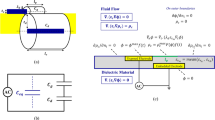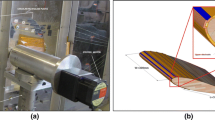Abstract
In the operation of cycloidal rotors the flow structure deformation, and associated curvature, limits the possibility of achieving an optimum working point. In this study, first, we started by performing a detailed analysis of the start-up characteristics of a cycloidal rotor in order to identify the evolution of kinematic and dynamic characteristics of its operation. Afterwards, we identified the effects of applying multiple plasma boundary layer control, of dielectric barrier discharge type. This application is defined in both sides of the blades, since in cyclorotor movement they change from pressure to suction side over one blade rotation. A control law is defined to regulate the operation of the plasma actuators as the rotor blade move in azimuthal direction. The coupled multiphysics simulation of the cyclorotor and plasma flow is performed by adding to Fluent two user define functions to model the complex cyclorotor movement and the plasma momentum effect. The k-\(\omega \) SST turbulence model is used in the computations. The study is performed for a cyclorotor comprised of six NACA 0016 blade profiles that rotate at 200 rpm. The results demonstrate the advantage of using multiple plasma actuators in order to control the blade flow field. In particular, the configuration with six actuators, three in each side, was the most effective, by improving the thrust by 2.3%, as compared to the base case, and achieving a reduction in power requirements of 0.9%.






















Similar content being viewed by others
References
Yun CY, Park IK, Hwang IS, Kim SJ (2005) Thrust control mechanism of VTOL UAV cyclocopter with cycloidal blades system. J Intell Mater Syst Struct 16(11–12):937–943
McNabb M (2001) Development of a cycloidal propulsion computer model and comparison with experiment
Benedict M, Mattaboni M, Chopra I, Masarati P (2010) Aeroelastic analysis of a MAV-scale cycloidal rotor. In: 51st AIAA/ASME/ASCE/AHS/ASC structures, structural dynamics, and materials conference 18th AIAA/ASME/AHS adaptive structures conference 12th, p 2888
Yong YC, Illkyung P, Yong LH, Sang JJ, Seong HI, Jo KS, Nam JS (eds) (2004) A new VTOL UAV cyclocopter with cycloidal blades system. In: American Helicopter Society 60th Annual Forum, Baltimore. Citeseer
Jakson M, Pascoa JC, Xisto C (2013) Analytical modeling of a cyclorotor in forward flight. Technical report, SAE Technical Paper
Leger JA, Páscoa JC, Xisto CM (2015) Analytical modeling of a cyclorotor in hovering state. Proc Inst Mech Eng Part G J Aerospace Eng 229(12):2163–2177
Jiwei Tang YH, Song B, Yang H (2018) An unsteady free wake model for aerodynamic performance of cycloidal propellers. Proc Inst Mech Eng Part G J Aerospace Eng 232(2):290–307
Kim S, Yun C, Kim D, Yoon Y, Park I (2003) Design and performance tests of cycloidal propulsion systems. In: 44th AIAA/ASME/ASCE/AHS/ASC structures, structural dynamics, and materials conference, p 1786
Hu Y, Kah L, Hu W (2006) The research on the performance of cyclogyro, p 7704
Hwang IS, Min S, Lee CH, Kim S (2008) Development of a Four-Rotor Cyclocopter. J Aircraft 45(2151–2157):11
Nakaie Y, Ohta Y, Hishida K (2010) Flow measurement around a cycloidal propeller. J Visual 13:303–310
Benedict M, Jarugumilli T, Chopra I (2013) Effect of rotor geometry and blade kinematics on cycloidal rotor hover performance. J Aircraft 50:1340–1352
Benedict M, Jarugumilli T, Lakshminarayan V, Chopra I (2014) Effect of flow curvature on forward flight performance of a micro-air-vehicle-scale cycloidal-rotor. AIAA J 52(6):1159–1169
Monteiro JAL, Páscoa J (2018) Effects of harmonic vibration on cycloidal rotor performance. In: ASME international mechanical engineering congress and exposition, vol 52002. American Society of Mechanical Engineers, p V001T03A003
Leger J, Páscoa J, Xisto C (2015) 3D effects in cyclorotor propulsion systems. In: ASME international mechanical engineering congress and exposition, vol 57342. American Society of Mechanical Engineers, p V001T01A004
Xisto CM, Páscoa JC, Abdollahzadeh M, Leger JA, Schwaiger M, Wills D, Masarati P, Gagon L (2014) PECyT-plasma enhanced cycloidal thruster. In: 50th AIAA/ASME/SAE/ASEE joint propulsion conference, p 3854
Xisto CM, Leger JA, Páscoa JC, Gagnon L, Masarati P, Angeli D, Dumas A (2017) Parametric analysis of a large-scale cycloidal rotor in hovering conditions. J Aerospace Eng 30(1):04016066
Habibnia M, Pascoa J (2019) ANN assisted flow modeling and analysis for a cyclorotor in ground effect. Aerosp Sci Technol 95:105495
Yu H, Chang T, Lang ZH (2014) An investigation into the effect of the airfoil on the aerodynamics of the MAV scale cycloidal propeller under hovering status. In: AIAA AVIATION 2014–14th AIAA Aviation Technology, Integration, and Operations Conference 01
Hu Y, Fu X, Zhang H, Wang G, Farhat H (2019) Effects of blade aspect ratio and taper ratio on hovering performance of cycloidal rotor with large blade pitching amplitude. Chin J Aeronaut 32(5):1121–1135
Stasko T, Dykas S, Majkut M, Smolka K et al (2019) An attempt to evaluate the cycloidal rotor fan performance. Open J Fluid Dyn 9(04):292
Gagnon L, Morandini M, Quaranta G, Masarati P, Xisto CM, Páscoa JC (2018) Aeroelastic analysis of a cycloidal rotor under various operating conditions. J Aircraft 55(4):1675–1688
McElreath JW, Benedict M, Tichenor N (2020) Cycloidal rotor-blade tip-vortex analysis at low Reynolds number. AIAA J 58(6):2560–2570
Rodrigues F, Mushyam A, Pascoa J, Trancossi M (2019) A new plasma actuator configuration for improved efficiency: the stair-shaped dielectric barrier discharge actuator. J Phys D Appl Phys 52(38):385201
Abdollahzadeh M, Rodrigues F, Pascoa JC, Oliveira PJ (2015) Numerical design and analysis of a multi-DBD actuator configuration for the experimental testing of Acheon nozzle model. Aerosp Sci Technol 41:259–273
West T, Hosder S (2012) Numerical investigation of plasma actuator configurations for flow separation control at multiple angles of attack. In: 6th AIAA flow control conference, p 3053
Shyy W, Jayaraman B, Andersson A (2002) Modeling of glow discharge-induced fluid dynamics. J Appl Phys 92(11):6434–6443
Massines F, Rabehi A, Decomps P, Gadri RB, Ségur P, Mayoux C (1998) Experimental and theoretical study of a glow discharge at atmospheric pressure controlled by dielectric barrier. J Appl Phys 83(6):2950–2957
Abdollahzadeh M, Pascoa JC, Oliveira PJ (2014) Modified split-potential model for modeling the effect of DBD plasma actuators in high altitude flow control. Curr Appl Phys 14(8):1160–1170
Abdollahzadeh M, Pascoa JC, Oliveira PJ (2018) Comparison of DBD plasma actuators flow control authority in different modes of actuation. Aerosp Sci Technol 78:183–196
Suzen Y, Huang G, Jacob J, Ashpis D (2005) Numerical simulations of plasma based flow control applications. In: 35th AIAA fluid dynamics conference and exhibit, p 4633
Jayaraman B, Shyy W (2003) Flow control and thermal management using dielectric glow discharge concepts. In: 33rd AIAA fluid dynamics conference and exhibit, p 3712
Visbal M, Gaitonde D, Roy S (2006) Control of transitional and turbulent flows using plasma-based actuators. In: 36th AIAA fluid dynamics conference and exhibit, p 3230
Orlov D, Apker T, He C, Othman H, Corke T (2007) Modeling and experiment of leading edge separation control using SDBD plasma actuators. In: 45th AIAA aerospace sciences meeting and exhibit, p 877
He C, Corke T, Patel M (2007) Numerical and experimental analysis of plasma flow control over a hump model. In: 45th AIAA aerospace sciences meeting and exhibit, p 935
Rizzetta DP, Visbal MR (2008) Plasma-based flow-control strategies for transitional highly loaded low-pressure turbines. J Fluids Eng 130(4):041104
Giorgi MGD, Motta V, Suma A (2020) Influence of actuation parameters of multi-DBD plasma actuators on the static and dynamic behaviour of an airfoil in unsteady flow. Aerosp Sci Technol 96:105587
Zhang PF, Liu AB, Wang JJ (2010) Flow structures in flat plate boundary layer induced by pulsed plasma actuator. SCIENCE CHINA Technol Sci 53(10):2772–2782
Cho Y-C, Shyy W (2011) Adaptive flow control of low-Reynolds number aerodynamics using dielectric barrier discharge actuator. Prog Aerosp Sci 47(7):495–521
Riherd P, Roy S, Visbal M (2011) Numerical investigation of serpentine plasma actuators for separation control at low Reynolds number. In: 41st AIAA fluid dynamics conference and exhibit, p 3990
Khoshkhoo R, Jahangirian A (2016) Flow separation control over airfoils using DBD plasma body force. J Braz Soc Mech Sci Eng 38(8):2345–2357
Borghi CA, Cristofolini A, Neretti G, Seri P, Rossetti A, Talamelli A (2017) Duty cycle and directional jet effects of a plasma actuator on the flow control around a naca0015 airfoil. Meccanica 52(15):3661–3674
Javadi K, Hajipour M (2017) Separation control using quasi-radial wall jets. Aerosp Sci Technol 68:240–251
Ebrahimi A, Hajipour M (2018) Flow separation control over an airfoil using dual excitation of DBD plasma actuators. Aerosp Sci Technol 79:658–668
Akbarzadeh P, Askari Lehdarboni A, Derazgisoo SM (2018) Low reynolds unsteady flow simulation around naca0012 airfoil with active flow control. Meccanica 53(14):3457–3476
Megawanto FC, Budiarso H, James J (2018) Numerical analysis of plasma actuator for drag reduction and lift enhancement on NACA 4415 airfoil. AIP Publishing LLC, p 050001
Ben-Harav A, Greenblatt D (2016) Plasma-based feed-forward dynamic stall control on a vertical axis wind turbine. Wind Energy 19(1):3–16
Ma L, Wang X, Zhu J, Kang S (2019) Dynamic stall of a vertical-axis wind turbine and its control using plasma actuation. Energies 12(19):3738
Omidi J, Mazaheri K (2020) Wind turbine generated power enhancement by plasma actuator. arXiv preprint arXiv:2004.07046
Worasinchai S, Ingram GL, Dominy RG (2012) The physics of h-darrieus turbines self-starting capability: flapping-wing perspective. Turbo Expo: Power for Land, Sea, and Air, vol 44724. American Society of Mechanical Engineers, pp 869–878
Biadgo MA, Simonović A, Komarov D, Stupar S (2013) Numerical and analytical investigation of vertical axis wind turbine. FME Trans 41(1):49–58
Zhu J, Huang H, Shen H (2015) Self-starting aerodynamics analysis of vertical axis wind turbine. Adv Mech Eng 7(12):1687814015620968
Tang J, Hu Y, Song B (2015) Investigation on the unsteady aerodynamics of cycloidal propeller in hovering flight. Proc Inst Mech Eng Part G J Aerospace Eng 229(13):2519–2536
Abdelraouf H, Elmekawy AMN, Kassab SZ (2020) Simulations of flow separation control numerically using different plasma actuator models. Alex Eng J 59(5):3881–3896
Yu H, Zheng J (2020) Numerical investigation of control of dynamic stall over a naca0015 airfoil using dielectric barrier discharge plasma actuators. Phys Fluids 32(3):035103
Benmoussa A, Páscoa JC (2021) Cycloidal rotor coupled with DBD plasma actuators for performance improvement. Aerospace Sci Technol 110:106468
Singh K, Páscoa JC (2018) Numerical modeling of stall and poststall events of a single pitching blade of a cycloidal rotor. J Fluids Eng 141(1):011103
Rezaeiha A, Montazeri H, Blocken B (2019) On the accuracy of turbulence models for CFD simulations of vertical axis wind turbines. Energy 180:838–857
Wills D, Schwaiger M (2012) In USEUCOM. Science & Technology Conference
Yoon J-S, Han J-H (2015) Semiempirical thrust model of dielectric barrier plasma actuator for flow control. J Aerosp Eng 28(1):04014041
Roth JR, Sherman DM, Wilkinson SP (2000) Electrohydrodynamic flow control with a glow-discharge surface plasma. AIAA J 38(7):1166–1172
Acknowledgements
This work was supported by Project “EMaDeS –Energy, Materials and Sustainable Development No 01-0145-FEDER-000017, co-financed by the Portugal 2020 Program (PT2020), within the Regional Operational Program of the Center (CENTRO2020) and the European Union through the European Regional Development Fund (ERDF). This work was also supported by C-MAST, Center for Mechanical and Aerospace Science and Technology Research Unit No 151 within ClusterDEM lab at Universidade da Beira Interior. (Portugal).
Author information
Authors and Affiliations
Corresponding author
Ethics declarations
Conflict of interest
The authors declare that they have no conflict of interest.
Additional information
Publisher's Note
Springer Nature remains neutral with regard to jurisdictional claims in published maps and institutional affiliations.
Rights and permissions
About this article
Cite this article
Benmoussa, A., Páscoa, J.C. Performance improvement and start-up characteristics of a cyclorotor using multiple plasma actuators. Meccanica 56, 2707–2730 (2021). https://doi.org/10.1007/s11012-021-01413-4
Received:
Accepted:
Published:
Issue Date:
DOI: https://doi.org/10.1007/s11012-021-01413-4




